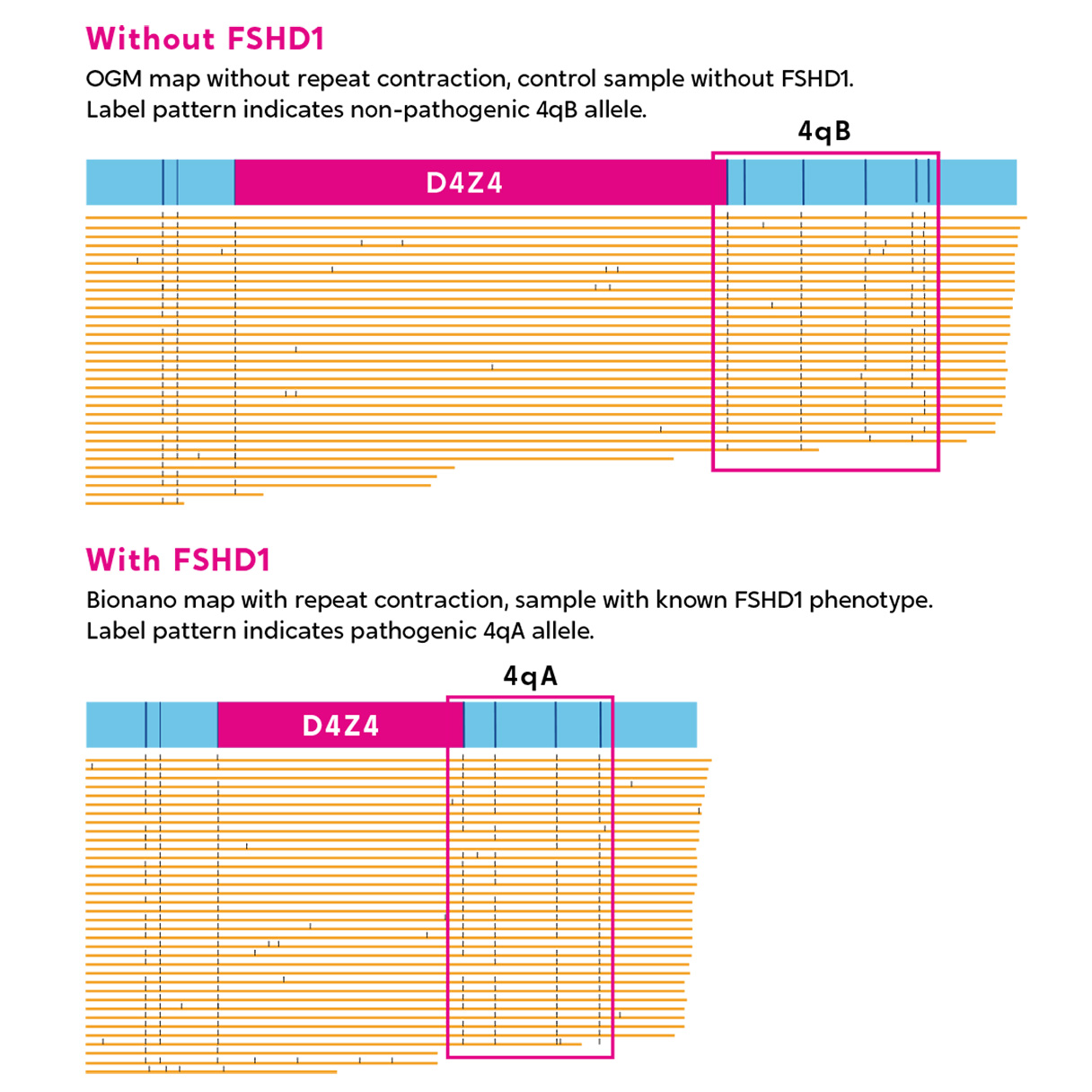Achieve Better Insights for Challenging Repeat Disorders Using Optical Genome Mapping with EnFocus Analysis
Repeat expansion disorders such as fragile X syndrome (FXS) and repeat contraction disorders such as facioscapulohumeral muscular dystrophy (FSHD) are typically caused by expansions or contractions in DNA repeats. Accurate measurement of the repeat region is essential but can be challenging and often requires PCR and Southern blot for accurate detection. PCR is accurate and fast but cannot size longer repeats. Southern blots use radioactive labeling, are labor intensive, and are inaccurate for repeat counts. Bionano EnFocus analysis can overcome these limitations by providing a single analysis and simple workflow using optical genome mapping (OGM) data that automates and enables accurate measurement of the repeat array size in as few as 3 days.

Achieve very high concordance for repeat detection compared with Southern blot and PCR.1
Bionano EnFocus analysis is a highly accurate, reliable, and streamlined molecular analysis workflow to measure the number of DNA repeats being investigated.
Simplify the Biological Complexity of FSHD Detection
Fascioscapulohumeral Muscular Dystrophy (FSHD) is a common form of muscular dystrophy with an extremely complex phenotype. Molecular detection requires the accurate sizing of a very large repeat region in the subtelomeric region of chromosome 4, a correct determination of the pathogenic vs. non-pathogenic allele, and the distinction between the chromosome 4 repeat and an almost identical repeat on chromosome 10 not related to the disease. EnFocus FSHD differentiates between permissive 4qA and non-permissive 4qB haplotypes and distinguishes the D4Z4 array present on chromosome 4 from the partially homologous D4Z4 array present on chromosome 10. EnFocus FSHD has shown 100% concordance to Southern blot for D4Z4 repeat array.


Accurately Identify Full Mutations in Fragile X Syndrome
Fragile X syndrome (FXS) is a common genetic disorder caused by a triplet repeat expansion within the FMR1 gene. Molecular detection requires the accurate sizing of a large CGG repeat region on chromosome Xq, distinguishing a repeat size of >200 triplets to confirm the present of a full mutation associated with the FXS phenotype. EnFocus Fragile X automates the process of sizing the CGG trinucleotide repeat array in the FMR1 gene in samples with OGM. The analysis provides the likelihood that the number of repeats is above or below the 200-repeat threshold associated with a full mutation for Fragile X syndrome. EnFocus Fragile X has demonstrated analytical sensitivity of 97%, with 100% positive predictive value.1
Learn more about OGM
Read about what structural variations are and why they matter.
Learn MoreSee how OGM reveals structural variation in a way that’s never been done before.
Learn MoreFind the latest research in our Publications Library.
Learn MoreDownloads and Resources
Optical genome mapping for FSHD detection.
Bionano optical genome mapping and Southern blot analysis for FSHD detection.
EnFocus Fragile X Workflow (Bionano Access v1.7, 30427A)

Schedule a time to review the software to see how it can deter and analyze repeat expansions
Request a DemoRelated Products

- Iqbal MA, et al. Multi-site technical performance and concordance of optical genome mapping: Constitutional postnatal study for SV, CNV, and repeat array analysis. medRxiv. 2021. doi: https://doi.org/10.1101/2021.12.27.21268432